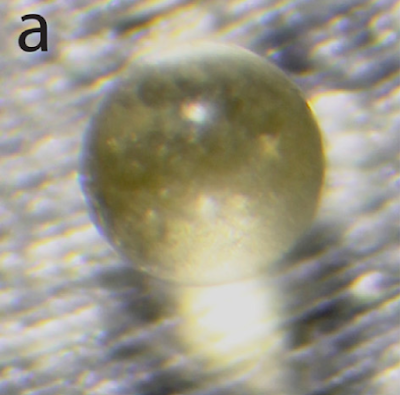Microtektites are microscopic glass spherules produced by the vaporisation of material from the Earth's crust due to hypervelocity impacts by extraterrestrial bodies. They are spherical in shape because they are formed by the cooling of liquid silica within the atmosphere. These are found in many locations, but can be linked together into regions related to, but typically far from, impact sites, known as scattered fields. To date four such scattered fields have been found on Earth, known as the Australasian, Central European, Ivory Coast and North American fields, each of which is thought to relate to a different impact event.
In a paper published in the journal Geochemica et Cosmochemica Acta on 6 March 2018, Matthias Van Ginneken of the Department of Earth Science and Engineering at Imperial College London, the Department of Earth Science at The Natural History Museum, the Department of Analytical, Environmental and Geo-Chemistry at the Vrije Universiteit Brussel, and the Laboratoire G-Time, Université Libre de Bruxelles, Mathew Genge, also of the Department of Earth Science and Engineering at Imperial College London, and Ralph Harvey of the Department of Geological Sciences at Case Western Reserve University, describe the discovery of a new microtektite producing area in a glacial moraine near Larkman Nunatak in the Transantarctic Mountains of Antarctica.
The new site and comprises a moraine roughly 1.5 km in length and 700 m wide, orientated in an east-west direction. 250 g of material was removed from this site in 2006, and subsequently washed and sieved, producing 52 glass spherules between 107 and 388 μm in diameter and pale yellow in colour; one of these contains a bubble 10 μm in diameter.
Stereomicrograph of three Larkman Nunatak microtektites. The scalebar is 100 lm. A vesicle is arrowed in (c). Van Ginneken et al. (2018).
Chemically these spherules fall within the Australasian Scattered Field, which have previously been found in deep sea sediments of the Indian and Pacific Ocean. These are the youngest of the four scattered fields, thought to have originated about 800 000 years ago from an impact somewhere in Southeast Asia, probably Vietnam, from which they are spread out in a three-lobed shape. The Antarctic microtektites are the furthest yet known from the presumed location of the impact, about 11 000 km away.
Sampling location of Larkman Nunatak microtektites. (a) Sketch map showing the sampling sites of Australasian microtektites and the current extension of the Australasian strewn field. (b) Regional map showing the locations where microtektites were found in the Transantarctic Mountains. (c) Panoramic view of Larkman Nunatak. Arrowed is the sampling area where glacial moraine was collected. (c) Detail of the sampling area. Van Ginneken et al. (2018).
The Antarctic microtektites are smaller than any previously found Austrolasian microtektites and more-or-less totally depleted in volatile elements. This fits with a consistent pattern within the Austrolasian Scattered Field, in which the further microtektites are found from the presumed impact site, the smaller and more depleted in volatiles they are. Van Ginneken et al. suggest that this is because the furthest material actually originates from closest to the impact site, and thus was thrown higher into the atmosphere, and therefore the microtektites are more altered the further they are found from this origin.
See also...
Follow Sciency Thoughts on Facebook.










